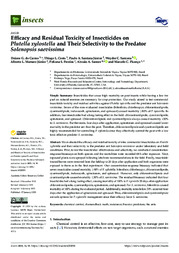Efficacy and residual toxicity of insecticides on plutella xylostella and their selectivity to the predator solenopsis saevissima.
Efficacy and residual toxicity of insecticides on plutella xylostella and their selectivity to the predator solenopsis saevissima.
Autoria: CARMO, D. G. do; COSTA, T. L.; SANTANA JÚNIOR, P. A.; SANTANA, W. C.; MARSARO JUNIOR, A. L.; PEREIRA, P. S.; SANTOS, A. A.; PICANÇO, M. C.
Resumo: Abstract: We evaluated the efficacy and residual toxicity of nine commercial insecticides on Plutella xylostella and their selectivity to the predator ant Solenopsis saevissima under laboratory and field conditions. First, to test the insecticides? effectiveness and selectivity, we conducted concentrationresponse bioassays on both species and the mortalities were recorded 48 h after exposure. Next, rapeseed plants were sprayed following label rate recommendations in the field. Finally, insecticidetreated leaves were removed from the field up to 20 days after application and both organisms were exposed to them as in the first experiment. Our concentration-response bioassay indicated that seven insecticides caused mortality ?80% of P. xylostella: bifenthrin, chlorfenapyr, chlorantraniliprole, cyantraniliprole, indoxacarb, spinetoram, and spinosad. However, only chlorantraniliprole and cyantraniliprole caused mortality ?30% of S. saevissima. The residual bioassay indicated that four insecticides had a long-lasting effect, causing mortality of 100% to P. xylostella 20 days after application: chlorantraniliprole, cyantraniliprole, spinetoram, and spinosad. For S. saevissima, bifenthrin caused mortality of 100% during the evaluated period. Additionally, mortality rates below 30% occurred four days after the application of spinetoram and spinosad. Thus, chlorantraniliprole and cyantraniliprole are safe options for P. xylostella management since their efficacy favor S. saevissima.
Ano de publicação: 2023
Tipo de publicação: Artigo de periódico
Unidade: Embrapa Trigo
Palavras-chave: Brassica, Chemical control, Controle Químico, Diamondback moth, Fire ants, Inseticida, Pesticide resistance, Predators, Toxidez
Observações
1 - Por padrão são exibidas publicações dos últimos 20 anos. Para encontrar publicações mais antigas, configure o filtro ano de publicação, colocando o ano a partir do qual você deseja encontrar publicações. O filtro está na coluna da esquerda na busca acima.
2 - Para ler algumas publicações da Embrapa (apenas as que estão em formato ePub), é necessário ter, no celular ou computador, um desses softwares gratuitos. Sistemas Android: Google Play Livros; IOS: iBooks; Windows e Linux: software Calibre.
Acesse outras publicações
Acesse a Base de Dados da Pesquisa Agropecuária (BDPA) para consultar o acervo completo das bibliotecas da Embrapa.

